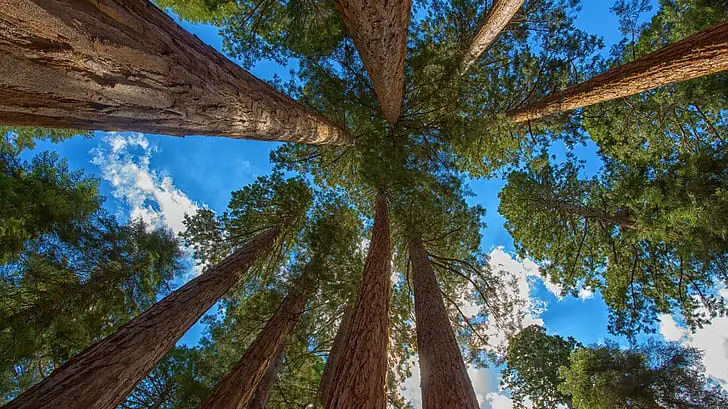
Discover how trees play a vital role in our environment. Ever wondered How Do Trees Reduce Air Pollution? Find out about nature’s own air filters and their impact on our health.
Ever wondered, How Trees Reduce Air Pollution? Well, you’re not alone.
It’s a question that’s been on the minds of many, especially as we grapple with the realities of climate change.
Trees, often referred to as the lungs of our planet, do more than just beautify our surroundings.
They are hard at work every day, silently cleaning the air we breathe.
Intrigued? Let’s delve deeper into this fascinating topic and uncover the remarkable ways trees help keep our air clean.
How Do Trees Reduce Air Pollution?
Have you ever stopped to think about how trees reduce air pollution? It’s a question that might seem simple, but the answer is truly fascinating.
In this post, we’re going to explore the incredible science behind how trees clean our air, the types of pollutants they combat, and the significant role urban trees play in this process.
We’ll also delve into the impact of trees on our health and identify which species are the most effective in reducing air pollution.
Plus, we’ll answer some frequently asked questions on the topic. So, let’s embark on this journey to appreciate the silent warriors of our environment, the trees!
Brief Overview of the Topic
Isn’t it amazing how nature has its own way of maintaining balance? One of the most remarkable examples of this is how trees reduce air pollution.
It’s a topic that’s gaining more attention as we become increasingly aware of the importance of sustainable living.
Trees, in their quiet and unassuming way, work as natural air purifiers, taking in harmful pollutants and releasing clean oxygen for us to breathe.
But that’s just the tip of the iceberg. The process is complex and truly fascinating, involving a series of natural mechanisms and interactions with the environment.
Importance of Trees in Reducing Air Pollution
Now, let’s talk about why this matters. Air pollution is a pressing issue worldwide, contributing to climate change and affecting our health in numerous ways.
It’s here that trees step in as silent heroes. By reducing air pollution, they’re not just making our air cleaner, but they’re also helping to combat climate change and protect our health.
From city parks to dense forests, every tree contributes to this cause. So, the next time you pass by a tree, take a moment to appreciate its silent service to our planet.
The Science Behind How Trees Reduce Air Pollution
Ready to dive into the science of how trees reduce air pollution? It’s a fascinating journey that takes us into the heart of a tree’s daily life.
From the process of photosynthesis to the absorption of pollutants and the release of oxygen, trees are nature’s very own air purifiers.
So, let’s roll up our sleeves and delve into the captivating world of trees and their role in keeping our air clean.
Trust me, you’ll never look at a tree the same way again!
Photosynthesis and Carbon Sequestration
Let’s start with photosynthesis, a process we all learned about in school.
Remember how trees take in carbon dioxide and sunlight to produce their food and release oxygen?
That’s photosynthesis in a nutshell. But there’s more to it. As trees absorb carbon dioxide, a major greenhouse gas, they’re also helping to reduce its levels in our atmosphere.
This process is known as carbon sequestration. So, every time you see a tree, remember, it’s not just standing there looking pretty.
It’s busy pulling carbon dioxide out of the air and storing it, playing a vital role in our fight against climate change.
Trees as Natural Air Filters: Absorption of Pollutants
Now, let’s talk about trees as natural air filters. In addition to carbon dioxide, trees absorb a variety of harmful pollutants, including sulfur dioxide, ammonia, nitrogen oxides, and particulate matter.
These pollutants are absorbed through the tiny pores in the leaves, known as stomata.
Once inside, these pollutants are either stored or metabolized, effectively removing them from the air.
It’s a natural and efficient air-cleaning system that’s been in operation for millions of years!
Release of Oxygen
Finally, let’s not forget about the oxygen. As part of the photosynthesis process, trees release oxygen back into the air.
It’s this oxygen that we breathe in every day. Without trees and other photosynthesizing plants, life as we know it wouldn’t exist.
So, the next time you take a deep breath of fresh air while walking in a park or forest, take a moment to thank the trees around you.
They’re the reason that breath of air is possible!
Types of Air Pollutants Reduced by Trees
As we continue our exploration of how trees reduce air pollution, let’s delve into the types of pollutants that trees help combat.
It’s not just about carbon dioxide. Trees are nature’s multi-faceted air purifiers, dealing with a range of pollutants from particulate matter to various gaseous pollutants.
Understanding these pollutants and how trees interact with them gives us a deeper appreciation of the crucial role trees play in our environment.
So, let’s get to know our invisible enemies and the silent heroes that protect us from them.
Particulate Matter (PM)
First on our list is particulate matter, often abbreviated as PM. These are tiny particles suspended in the air, some so small that they’re only visible under a microscope.
PM can originate from various sources, including vehicle exhausts, industrial emissions, and even natural sources like dust and pollen.
Why are they a concern? Well, when inhaled, these tiny particles can cause a range of health issues, from respiratory problems to heart disease.
But here’s where trees come to our rescue. The leaves of trees, with their vast surface area, act like a trap, catching these particles and preventing them from floating around in the air we breathe.
Gaseous Pollutants: Sulfur Dioxide, Carbon Monoxide, Nitrogen Oxides
Next up are gaseous pollutants, including sulfur dioxide, carbon monoxide, and nitrogen oxides.
These gases are primarily released from burning fossil fuels and can have harmful effects on both our health and the environment.
But, just like with PM, trees are on the front lines, absorbing these gases through their leaves.
Once inside, these gases are either stored or broken down, effectively reducing their concentration in the air.
Greenhouse Gases: Carbon Dioxide
Last, but certainly not least, is carbon dioxide, a major greenhouse gas.
While it’s a natural part of the Earth’s atmosphere, human activities, particularly the burning of fossil fuels, have led to increased levels of carbon dioxide in the air.
This is a major contributor to climate change. But, as we’ve already learned, trees are nature’s carbon sequestration experts.
Through the process of photosynthesis, they absorb carbon dioxide, use it to produce their food and store the excess, helping to reduce the levels of this greenhouse gas in our atmosphere.
So, every tree is a valuable ally in our fight against climate change.
The Role of Urban Trees in Air Pollution Reduction
Now that we’ve explored the science behind how trees reduce air pollution and the types of pollutants they combat, let’s shift our focus to the urban environment.
You might be wondering, Do trees in cities and towns make a difference? The answer is a resounding yes!
Urban trees, often overlooked amidst concrete and skyscrapers, play a crucial role in improving air quality.
They’re our green warriors in the heart of the city, silently working to make our urban spaces healthier and more livable.
So, let’s dive in and discover the importance of these urban trees in reducing air pollution.
Urban Heat Island Effect and Pollution
Have you ever noticed how it feels hotter in the city than in the countryside?
That’s due to something called the urban heat island effect. Buildings, roads, and other urban structures absorb and re-emit heat, making cities warmer than surrounding rural areas.
This increased heat can exacerbate air pollution, as many pollutants react with sunlight and heat to form harmful substances like ground-level ozone.
But guess what? Trees can help mitigate this effect. By providing shade and releasing moisture into the air, trees can help cool down urban areas, reducing the heat island effect and, consequently, air pollution.
Benefits of Urban Trees
Now, let’s talk about the other benefits of urban trees. Apart from cooling down cities and reducing air pollution, urban trees provide a host of other benefits.
They add beauty to our urban landscapes, creating green spaces that offer a respite from the concrete jungle.
They also improve mental well-being, with studies showing that green spaces can help reduce stress and increase feelings of happiness.
Plus, they provide habitats for urban wildlife, contributing to biodiversity even in city environments.
So, the next time you walk past a tree on your city street, take a moment to appreciate all the amazing things it’s doing for you and your urban community.
The Impact of Trees on Human Health
As we continue our exploration of how trees reduce air pollution, let’s take a moment to consider their impact on our health.
It’s easy to overlook, but the quality of the air we breathe can significantly affect our well-being.
And trees, in their role as natural air purifiers, have a direct and positive impact on our health.
From reducing respiratory diseases to promoting mental health, trees are indeed nature’s healthcare providers.
So, let’s delve deeper into how these green giants contribute to our health and well-being.
Reduction in Respiratory Diseases
Let’s start with respiratory health. Air pollution is a known trigger for respiratory diseases like asthma and chronic obstructive pulmonary disease (COPD).
It can also lead to other health issues, including heart disease and stroke. By reducing air pollution, trees help to lower the risk of these diseases.
Think of trees as a giant outdoor air purifier. They filter out harmful pollutants and release clean oxygen, making the air healthier to breathe.
So, living in areas with more trees can actually help people breathe easier, especially those with respiratory conditions.
Mental Health Benefits
Now, let’s talk about mental health. It’s not just our physical health that benefits from trees; our mental well-being does too.
Spending time in green spaces, surrounded by trees, has been shown to reduce stress, anxiety, and depression.
It can also improve mood and boost overall happiness. This is often referred to as ‘forest bathing’, a practice that originated in Japan and is now recognized worldwide for its mental health benefits.
So, trees not only clean our air, but they also help to keep our minds healthy.
It’s just another reason to appreciate the amazing benefits of trees.
VI.The Most Effective Trees for Air Pollution Reduction
As we’ve discovered, all trees help reduce air pollution to some extent.
But did you know that some trees are particularly good at it? Yes, certain species are more effective at cleaning the air than others.
Factors such as the tree’s size, leaf shape, and the environment it grows in can all influence its ability to reduce air pollution.
So, let’s delve into this topic and discover which trees are the most effective air purifiers.
It’s a fascinating exploration that might just influence your next tree-planting decision!
Species That Are Most Effective in Reducing Air Pollution
When it comes to air pollution reduction, not all trees are created equal. Some species are particularly good at it.
For instance, large, mature trees with broad leaves, like oaks and maples, are excellent at absorbing pollutants.
Evergreens, like pines and spruces, are also effective because they keep their leaves all year round, allowing them to clean the air continuously.
And let’s not forget about the humble birch, which is particularly good at absorbing particulate matter.
So, if you’re considering planting a tree to help clean the air, these species might be a good place to start.
Factors That Influence a Tree’s Ability to Reduce Air Pollution
But it’s not just about the species. Several factors can influence a tree’s ability to reduce air pollution.
The tree’s size is a big one. Larger trees with more leaves can absorb more pollutants.
The tree’s health is also important. Healthy trees are better at absorbing pollutants than trees that are sick or stressed.
The environment plays a role too. Trees in urban areas, where pollution is often higher, can have a bigger impact on air quality than trees in rural areas.
And finally, the local climate and weather conditions can affect how much pollution a tree can absorb.
So, while planting any tree is beneficial, considering these factors can help maximize their air-cleaning potential.
Do Trees Reduce Air Pollution? FAQs
As we’ve journeyed through the world of trees and their role in reducing air pollution, you might have a few questions brewing.
Well, you’re in luck! In this section, we’ll tackle some of the most frequently asked questions about trees and air pollution.
From the capacity of a single tree to absorb pollution to the best trees to plant for air pollution reduction, and even how trees reduce noise pollution, we’ve got you covered.
So, let’s dive into these FAQs and quench our thirst for knowledge!
Q: How much pollution can a single tree absorb?
A: The amount of pollution a single tree can absorb depends on several factors, including its species, size, age, and health.
On average, a mature tree can absorb approximately 48 pounds of carbon dioxide per year.
However, this is a rough estimate and the actual amount can vary significantly.
Q: What are the best trees to plant for air pollution reduction?
A: Some tree species are particularly effective at reducing air pollution.
Large, mature trees with broad leaves, like oaks and maples, are excellent at absorbing pollutants.
Evergreens, like pines and spruces, are also effective because they keep their leaves all year round, allowing them to clean the air continuously.
The humble birch is particularly good at absorbing particulate matter.
Q: How do trees reduce noise pollution?
A: Trees can help reduce noise pollution by acting as a natural sound barrier.
The thick foliage of trees can absorb, deflect, and scatter sound waves, reducing the amount of noise that reaches beyond the trees.
This is why you might notice a significant reduction in noise levels when you enter a heavily wooded area.
Planting trees strategically around a noisy area can help create a quieter environment.
How Do Trees Reduce Air Pollution? Final Thoughts
As we reach the end of our exploration into how trees reduce air pollution, it’s clear that these green giants do a lot more than just provide shade and beauty.
They’re hard at work every day, cleaning our air, protecting our health, and combating climate change.
And while all trees contribute to this cause, some species and factors can maximize their impact.
So, as we wrap up, let’s take a moment to appreciate the silent service of trees and consider how we can support them in return.
After all, every tree planted is a step towards a cleaner, healthier planet.
The Role of Forests in Air Pollution Reduction
Forests, as vast collections of trees, play a significant role in reducing air pollution on a global scale.
They act as massive air filters, absorbing a wide range of pollutants and releasing clean oxygen.
Forests also play a crucial role in carbon sequestration, helping to combat climate change.
Moreover, they provide habitats for countless species, contributing to biodiversity.
Protecting our existing forests and planting new ones is, therefore, a critical step in maintaining air quality and overall planetary health.
The Importance of Tree Planting Initiatives
Given the significant role trees play in reducing air pollution, tree-planting initiatives are more important than ever.
These initiatives, whether led by governments, non-profit organizations, or community groups, contribute to the global effort to improve air quality and combat climate change.
Participating in or supporting these initiatives can be a practical way for individuals to make a positive environmental impact.
Plus, these initiatives often have additional benefits, such as improving local green spaces, providing habitats for wildlife, and fostering a sense of community.






